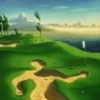From the large walls in your images, it appears you are not correctly scaling and offsetting your elevation values in GlobalMapper. There will be an option on the elevation data layer to do this.
For example, if your course ranges in altitude from 2000m to 2050m, you'll want to get rid of that base 2000m offset, like the course was at sea level. If you leave that offset in, your terrain in Unity will be 2000m up in the air with only a small portion of your 65 thousand vertical resolution to represent 50m. That could be the stepping.
You'll also want that 50m height range across the course to occupy the full height range allowed by RAW file. This is why scaling in GlobalMapper is needed. This could be the reason for the flat image.
The thing about RAW files is there is no standard--they're just a bunch of numbers which can go from top right to bottom left or any other sequence. Importers like Unity must be told the specs of the RAW file coming and will glady accept even 32 bit RAW files if the number of samples is right. It won't process them correctly though.
You may even find GlobalMapper's RAW format is undecipherable by Unity. In that case you would need to export it as something like GeoTiff, and convert it to RAW in something that Unity does understand (like Photoshop).
The other thing you'll highly likely have to do is rotate and/or flip your height map in something like Photoshop to match your overlay image. Plus ensure your scaling and offset in GlobalMapper give room for bunkers and water beds to be dug out,
Before readers freak out thinking they'll need to know this stuff, they won't. Terrain Forge exists to solve these complications.























